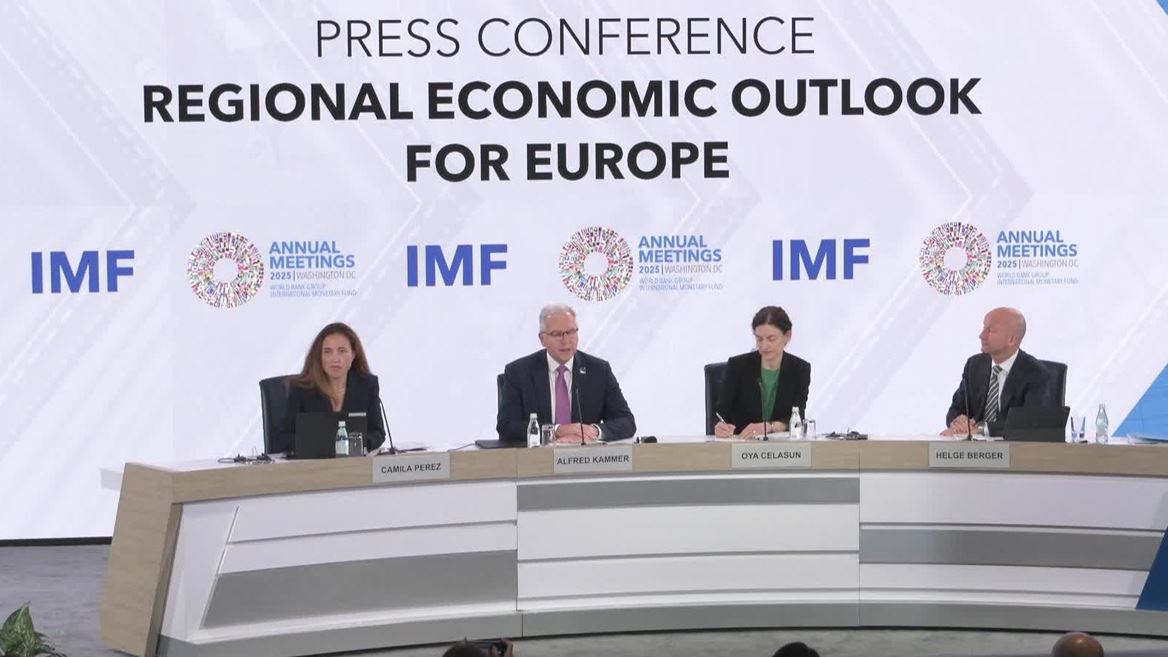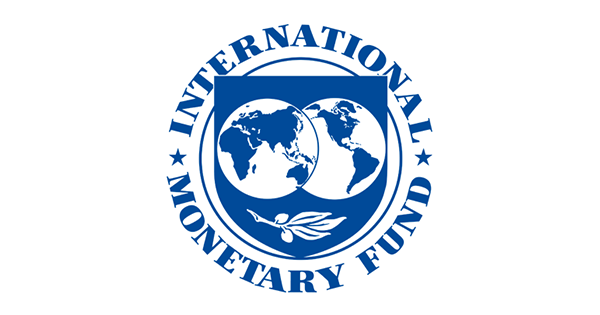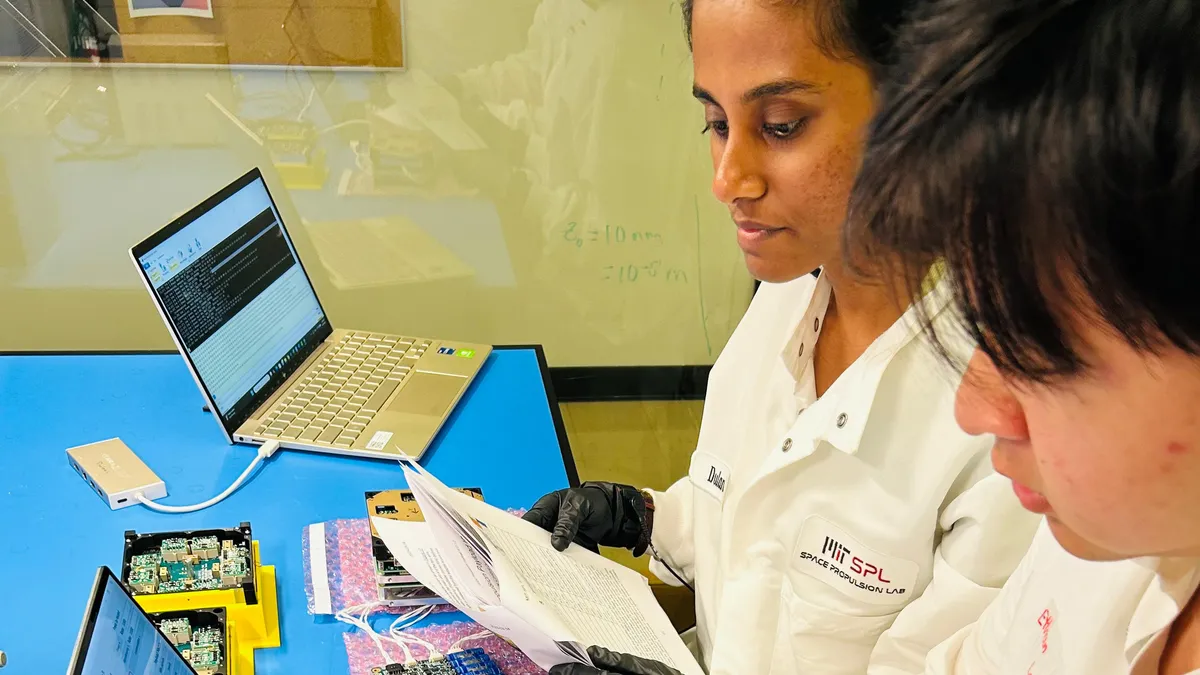Press Briefing: Europe Regional Economic Outlook
October 17, 2025
Speakers:
Alfred Kammer, Director, European Department, International Monetary Fund
Helge Berger, Deputy Director, European Department, International Monetary Fund
Oya Celasun, Deputy Director, European Department, International Monetary Fund
Moderator:
Camila Perez, Senior Communications Officer, International Monetary Fund
PEREZ: Hi everyone. Welcome to this press conference on the European economic outlook. My name is Camila Perez. I’m with the Communications Department at the IMF.
We’re joined here by Alfred Kammer, he’s the Director at the European Department. We’re also here with Oya Celasun and Helge Berger, both are Deputy Directors at the European Department of the IMF.
As usual, we’re going to get started with some opening remarks, and then we will turn to your questions. We’ll go to the room and WebEx.
And I think with that, we can get started.
KAMMER: Thank you, Camila, and welcome to everybody here to our press conference. We posted some longish opening remarks. I will just then make some short remarks for emphasis.
First point, the pandemic and the energy crisis were huge shocks. And because of good policymaking, we entered into a recovery, and the recovery unfolded as we expected. And what we see is now the end of that recovery, and the end of that recovery goes into the medium-term dismal, mediocre growth for Europe. That is what we have been predicting.
Second point to make, on the short-term, the recovery is being driven by higher real wages, and they are supporting consumption, lower interest rates are providing support to investment spending, and we are facing headwinds and new headwinds since earlier this year. And they come from trade tensions and geopolitical attentions. And when you’re looking at our short-term forecast for this year, they are being influenced by front-loading as a response to these tariff threats earlier on, before they became available. And when we’re looking at the impact of trade tariffs and uncertainty for 2025-2026, they are going to shave off growth by 0.5 percent cumulatively. And they’re only partially offset by higher infrastructure spending projected for Germany and higher defense spending.
So that’s on the growth side. On the disinflation side for the euro area, ECB, mission accomplished. So there we have — so that, of course, is a momentous thing because we have reached the inflation target and it looks like we have reached that durably. And what it means for ECB monetary policy is that they can stay at a terminal rate of 2 percent. And our recommendation for the ECB is to only change the policy rate if or when material shocks strike, which would materially change the inflation outlook.
A slightly different situation in the CESEE countries, where inflation is still 1 to 3 percentage points above target, there is still a risk of the anchoring of inflation expectations. And therefore, CESEE countries need to be more cautious in the disinflation effort. They need to remain data dependent, meeting by meeting, and need to ease only gradually.
So our main recommendations for Europe is really focus on this dismal medium-term growth, and that means European-level reforms. We have outlined a number of reform areas. First, reduce intra-European trade barriers. Second, prepare for deeper capital markets with the capital markets union. Third, allow labor to move; that talent moves where the high productivity jobs are. And very importantly, energy costs are too high. Energy is too volatile, and we need an energy union which actually provides cheap energy with low volatility.
So those are the four reform areas which we have been proposing. We also have been proposing structure reforms and transformation reforms at the national level. They are also necessary in order to boost productivity. And the good news there is that Europe has excellent examples in place on what to do and how to do it. We put these reforms together, and they would — the Euro-level reforms first step and structure reforms domestically, they would actually give a boost to the level of GDP over 10 to 15 years by 9 percent. That’s a large number.
Use the European budget in order to incentivize reform. Use the European budget to actually generate savings for the European public goods. And those are public investments into R&D. Those are public investments into energy and into defense because a coordinated approach will overall provide savings and will provide a more effective system.
We add a big message this time to our REO, and that is, you also need to focus on fiscal consolidation. The package on the European reform and on the structural reforms that is going to create, when implemented, a lift in productivity, it will increase the income of European, and it provides resilience, and it will also help on the fiscal consolidation side.
So why focus on fiscal consolidation? Because long long-term spending pressures, which we have been pointing out before on aging-related health care spending with regard to pensions, digital transformation, the clean energy transitions, and higher interest rates, which budgets are going to face. They are going to add spending pressures over the next 15 years and the following decades. And what we are simulating in our Regional Economic Outlook is if Europe and European countries beyond the EU were to stay with current fiscal policies and were not to adjust those, then, given these spending pressures, debt would double over the next 15 years and would increase for the average European country to 130 percent of GDP.
So two messages on that. Policymakers were reminded that the long-term, unfortunately, starts here and now. When long-term spending pressures on defense and security moved into the 2025 budget. And what we want to remind everybody, do the structure reform and the productivity-enhancing measures because they will not only increase your income, there will also be a considerable contribution to the fiscal adjustment effort. And they could lower the fiscal adjustment requirement over the next five years by one-third to one-half of the effort. So, a huge and important contribution to make from these.
So, all clear. And also I would say when you talk to European policymakers, very much agreed by all of them and it’s always in the implementation and to overcome the political economy resistance. And that’s a really tough part to do. And we are trying to support European policymakers in creating a narrative because you need to discuss this with the population. We are providing numbers on the huge benefits of actually acting, and policymakers need to find ways to overcome these obstacles and act. And our view is Europe can act, Europe must act, and Europe must do so now.
Thank you.
PEREZ: Thank you so much, Alfred. We’re going to get started in the room. I know some of you have submitted questions on WebEx. We will get to those. I am going to get started with gentlemen on the fourth row.
QUESTIONER: Good morning. Thank you for doing this. In the report, it is said that consideration could be given to adapt the European Union’s policymaking hierarchy and to shorten the decision-making process in support of the structural reform agenda. This could, for example, involve moving toward majority voting rather than broad-based unanimity or allowing cutouts for progress among the willing and unanimity. Could you please elaborate on that, because I think it’s a bit difficult in the implementation part.
KAMMER: So the bottom line is everything is going to be difficult and complex, and we need to move. Our recommendation, when you’re looking at the governance structure and the decision-making process in the EU, and it’s agreed that it’s a complex one, speed it up wherever you can. Spain has started with using a provision in the treaty of moving with the coalition of the willing to move aggressively on some capital markets or savings investment, and union reform. We also suggest to look into where you can make decision-making easier by using majority voting. But that is also a recommendation for the future because when the union becomes bigger and views become more diverse, you need to look at the governance structure and decision-making process. So that’s something also for the longer term.
In the short term, our recommendation is also be smart in terms of how you are making decisions on reforms and how you start rolling them out. One suggestion we have is bundling of reforms. One of the big issues and explanations policymakers need to do domestically is why do we care about these EU reforms? Why do I need to go against some of the interests in my country which are expecting to lose out as part of the reforms? So we put a bundle of reforms together on the EU reform side. It’s really a down payment of the reforms. We have been suggesting that over the next 10 years would provide a boost to the level of GDP of 3 percent. And we look country by country of who would win, who would lose.
And the fantastic news is there are no losers. The country who will gain least gets a boost in GDP level of 2 percent. The country who gains most gets an increase in 5 percent. Everybody wins. And that is something policymakers need to think about on how to overcome resistance. We have fantastic examples in Europe with regard to how to implement structural reforms and deal with the political economy dialogue. We have many countries who were very successful doing this, looking at the timing of reforms, the sequencing of reforms, the communication part. And peers need to learn from each other. And that is an important part in terms of overcoming these obstacles and moving and acting on all these reform proposals, which based on Draghi and letter, most policymakers actually agree to
PEREZ: Thanks so much. We’re going to go to the second row. The gentleman here in the center, please.
QUESTIONER: Thank you. So I have two questions on Ukraine, which is continuing to struggle with the war, which has an impact on the European economy and wider. Following the IMF’s discussions with the Ukrainian government here and international donors, has the IMF advanced toward getting financing assurances for a new arrangement with Ukraine? And secondly, the latest World Economic Outlook, Fiscal Monitor, and other key indicators generally upheld the April projections for Ukraine, but slightly worsened the prospects for 2026, especially in the context of the current account balance and general government gross debt. Could you comment on these dynamics? What projections on when the war might end did you use and how would you describe the state of Ukraine’s economy now?
PEREZ: Thanks. Before we get to that, are there any other questions on Ukraine? Please, the lady on the first road here.
QUESTIONER: Hi, according to the IMF’s forecast, Ukraine’s public debt is expected to rise above 100 percent of GDP in 2025. Has this projection influenced on the ongoing agreement with the Fund? And where are we with it for now? And also, please can you comment that the recent report by Ukraine’s [Accounting Chamber] says that the ways of failure to meet commitments under the Ukraine’s facility with the IMF problem lead to miss budget revenue at like 5 million euros. Can you clarify what exactly went wrong with Ukraine and can we fix it now? Maybe we know where we are going with it and are already working with it. Thank you.
PEREZ: We’re going to one last question from WebEx. Please go ahead.
QUESTIONER: Good morning, everyone. I have a question regarding the IMF program. The question is about reparation loans. The cash from immobilized Russian assets should be transferred to the EU-issued bonds. Does the IMF see any risks for Europeans capital markets in this operation? I would really like to hear your feedback on the matter.
KAMMER: So let me first update you on the program.
The Ukrainian authorities requested a new program with the IMF recently. And we have started discussions both with the Ukrainian authorities on the macro framework of such a program, and also what kind of measures on the structural transformation side would be useful, which would be useful to support under such an IMF program. That is one part of the discussions we are having. And these discussions are progressing, and they have progressed also during this week. But this will be a process which will take some time, and this has just been the beginning of that process.
A second part of the IMF program, of course, is we need to ensure that the financing is in place. And as you know, the financing relies on donors and financing requirements are large. So Ukraine has started these discussions with donors to close the financing gap. And we have been involved in these discussions as well to outline what these financing gaps could be. Again, these discussions are still ongoing, and they will also take some time.
With regard to the financing modality, which was mentioned from our WebEx reporter, we don’t have a particular view on the financing modalities. What we recommend when it comes to the utilization of frozen Russian assets, that countries who consider doing this look for a strong legal underpinning before doing so, and are also beware of any implications for the international monetary system. So that’s our recommendation there.
With regard to the growth projections on Ukraine, they have indeed been dented. And that is a reflection of what we see in terms of attacks by Russia on the energy infrastructure, in particular. They also happen on the civilian population. So, that is reflected in these projections. We are also reflecting in there that clearly the Ukrainian government has indicated that the war will last longer, the war will be lasting during 2026, and that is also reflected in our projections there.
When it comes to the current account balance developments, the change you’re seeing in our projections for 2025 is a reflection of that. We see higher imports. On the one hand, on critical imports which are required by Ukraine in its ongoing war effort. But they also reflect increasing imports by the population, given the loss of competitiveness in the economy. So imports have been projected to increase.
Indeed, when we are doing a projection on the macro framework, we are also assessing the implications for public debt. And as you know, one of the objectives of any IMF program is to establish, by the end of the program, external viability and debt sustainability. So debt paths will also be discussed as part of this program.
On the [Auditor General], I think you were referring to the Ukraine facility, which is an EU facility. And that is really something for the EU to comment on, rather than for us to comment on. We made our most recent disbursement to Ukraine as expected in the Eighth Review, and that was done as we proposed.
I should say in general it’s important for Ukraine to continue its strong reform effort because the reforms on the anti-corruption side, on governance side, on strengthening institutions, really big time important in terms of setting Ukraine up for the restructuring phase and then to become as part of the EU accession efforts, a modern state. So, these structural reform efforts need to be carried out.
And I should say one part of the program is also clearly a focus on domestic revenue mobilization. Donors are providing substantive support to Ukraine, but Ukraine also needs to support its budget, do a bit — a very determined effort to raise revenue, and we need to look at revenue measures which are durable. And I’m stressing the word durable because again, this is to set up Ukraine for the reconstruction phase and that is to set up, well, Ukraine and for becoming a modern state as part of the EU accession. And that is very important.
And I should say I’m very happy that the Ukrainian authorities have a very forward-looking attitude beyond this war and want to set the conditions right on the structure of the economy and also on the structure of the government and state to support social spending, which the population will be expecting.
So I think those were all the questions which were asked.
PEREZ: Back to the room. I’m going to get the gentleman on the fifth row to the right, please.
QUESTIONER: Hi. I know that British Chancellor Rachel Reeves met the IMF’s Kristalina Georgieva yesterday, and one of the topics was sort of changes to Britain’s fiscal forecasts. And I wanted to check whether the IMF had a sort of specific recommendation in terms of how those should be changed beyond simply just doing fiscal checks once a year. And also sort of more broadly, British productivity has been weak. Can you talk a little bit about whether you think that artificial intelligence does offer sort of genuine benefits there, and whether sort of the U.K. potentially has greater scope for benefit with a heavy services-dependent sort of economy.
BERGER: Thanks for this question. Yes, we saw there was a discussion about the fiscal framework, and we have been on the record on these ongoing reforms in the U.K. We appreciate the reduction of the budget events to just once a year. I think this is the right approach. Once a year is what most countries are doing. It is the right balance between flexible and remaining flexible and adjusting to changing circumstances and not creating noise that, you know, ultimately will make the financial markets more nervous than assure them of the direction of the public finances.
With that said, there’s still a lot of volatility in around the framework. We think there are two areas where we could see room for improvement. One has to do with the forecasts that come out of the OBR. We think that, in general, one appraisal, one full-scale appraisal of the budget, including taking account of the newest macro forecast, is the right way to go. That doesn’t mean there’s not helpful use of multiple forecasts a year. But then, if you have two forecasts in the year, one of them would be not a full appraisal but would be focusing on the basic macroeconomic developments and maybe talk in a general way about fiscal outcomes. But it would be different from the one that leads that sets up the budget discussion itself.
Another area where there may be room for improvement has to do with the headroom in the budget. This is a complex topic. You want to have enough headroom not to create sort of short-term pressures that would require adjustment as circumstances change. On the other hand, large headroom is also fiscally costly. So, one would have to look at this carefully and weigh these different arguments.
Now, AI may help you do all of this better. So, we certainly think that AI, not just for the public sector, but also for the private sector, for all economies in Europe, but also elsewhere, has a potential upside. It could be very large for some economies. And it’s correct that economies like the U.K. that have a large services sector with a lot of skilled people operating there, in the U.K., it’s mostly in the financial sector, you could benefit from amplified productivity associated with the use of AI. On the other hand, there are other sectors in the economy. Again, that’s typical for any economy, not just for the U.K., where AI may have a different impact. So we have to watch this closely and weigh the risks and be ready to supplement whatever AI is doing good with labor market policies, upskilling, and so on, to help everybody benefit from it. I hope this was upbeat enough on AI.
PEREZ: Thanks. I want to make sure we get the questions from those joining online. We got via the Press Center a question on Italy. I’m going to read it out loud. Italy’s consumption is stagnating, adding to a tariff-related weakening in the country’s export and reflecting a weak growth in real wages and a slow recovery in buying power. Past recent inflationary shocks. Could Italy’s budget law help by lowering middle-class tax rates? Should this be a fiscal priority?
BERGER: Thanks for that question. Well, it’s true that growth in Italy is not very high. I think in our estimate, Italy hovers around 0.5-0.7 percent between now and 2030, and that makes it more difficult to get debt levels down. We hope that Italy will continue working to reduce its debt levels both through increasing productivity and growth, and to fiscal adjustment.
So let’s talk a little bit about how growth could be improved in the country and why is this important. If we support growth in general, this is a sustainable way of propping up incomes at the household level for the foreseeable future. Reforms are key. The NRRP, so Italy’s performance inside the European NRRP, program has been very helpful. We feel that it has made an impact on productivity and will support it. And if you could continue this reform effort with a national reform program after the NRRP runs out, even better.
In general, the areas where Italy, like many countries, can benefit from these reforms have to do with labor market participation. Italy is an aging economy, so making sure that everybody who can work is actually participating, especially when you look at female labor market participation, is important. But there’s also skills. There’s a deficit of high-skilled workers in the Italian labor market that calls for policies that address this. Firm dynamics are also very weak in Italy. Smaller firms stay small; they don’t grow fast enough. And if this sounds familiar, then it is because that is indeed a problem that we see in other European economies as well. So, national reforms focused on this will help. At the EU level, integrating the single market more closely will help capital market union can create access to finance.
So very important on the specific measures that are being discussed on the budget currently. We’re still waiting for the details of the Italian discussions on the new budget, and we will sort of speak to this then. But clearly, other than growth, fiscal consolidation is important to get debt levels in Italy on a declining path in a decisive way. We note the very impressive fiscal overperformance Italy has shown last year. And according to the newest data out of Italy, it seems that we’re going into another impressive overperformance that is better than expected by the authorities.
Headline deficit outcomes this year. This is fantastic. You will have seen that our own forecast for this year was for a headline deficit of 3.3 percent of GDP. According to the Italian authorities, this will be 3.0. Once we update our forecast, we will be reflecting this in full. And we generally support Italy’s efforts to continue fiscal consultation alongside structural reforms. As Alfred said earlier, that’s for all of our advanced economies with relatively high debt. The best way forward to get the fiscal space we need for whatever comes next.
PEREZ: Back to the room. I’m going to go with the gentleman on the third row here, please.
QUESTIONER: I have two questions on Spain. First one is I’d like you to explain which economic sectors have helped the IMF to improve the Spanish forecast for this year, and which economic sectors are slowing this growth in the next two years. And then the second one is if you can explain how the housing crisis and the rising of the cost of living in Spain is going to affect the Spanish economy in the next years. Thank you.
KAMMER: So the Spanish economy has been performing fantastically over the last few years, with really bumper growth rates in the order of 3 percent. And we upgraded again in our outlook growth for this year and also for next year. Our expectation is that growth will remain robust in the near term but will slow down then in the medium-term. And one of the big growth drivers was exports of services. And I should say this was not only tourism, but this also was IT communication, new sectors. And that is, I think, fantastic news for the Spanish economy.
The Spanish economy has also been really benefiting from an employment boom. So unemployment has decreased, and three-quarters of the increase in employment actually came from immigration. So, Spain took advantage of increased immigration in order to help these GDP numbers on the supply side.
So going forward, our recommendation for Spain is to focus on productivity-enhancing reforms, which are in particular supporting the newer sectors in the economy. And as other European countries, Spain would benefit from the broader EU reform packages on reducing trade barriers. Spain is making a particular effort on moving fast on the savings and investment union. And of course, labor mobility is helping as well. And when I’m looking at labor, what Spain needs to do is really focus on active labor market policy. The population is aging, and so bringing down the unemployment rate further and increasing participation rates is going to be important.
Since we are there, I think an important part is also for Spain to focus on fiscal consolidation. For that, it will be important to get a budget agreed in order to get high-quality measures in order to do that. And we are proposing to the Spanish government to front-load the fiscal adjustment. We don’t have — we have an agreement on the size of the consolidation need, but front loading would actually help in terms of creating confidence on the market side, fortifying against shocks, and goes into a virtual circle because your interest rates will get lower more quickly, which helps the private sector to invest. Private sector investment creates growth, and growth creates tax revenue, and that is one recommendation to Spain.
On housing, Spain is not the only country where housing is a big issue. We did a study in 2021 for all European countries, and housing affordability was flagged as one of the big issues which need to be taken care of. One suggestion was to really work on the supply side, i.e., that is, we need action on planning zoning in order to actually provide the environment that more housing is being built. That’s one part.
The second part, when you look at Europe all across, social housing supported by government over the last decades has considerably fallen. And that becomes an issue in many European countries. And it shows up as an increase in house prices, and it shows up as unaffordability for young people to get housing. And to make the connection to growth that makes it impossible for young people to actually move to the high productivity centers, which many times are in the urban centers. And when labor cannot move, where labor is needed, or where productivity is high, and where wages would be higher, that creates a huge dent on growth. And that is to the detriment, not just of the people who cannot move, but it’s to the detriment of the society because the income generated will be less.
And so the appeal to Spain, but to many other countries in Europe, including in Portugal, including Ireland, and many others, to focus on the housing crisis, the housing affordability crisis, and to move, and not just because of affordability issues, but also because of growth issues.
PEREZ: I want to read out loud another question that we got from a reporter in Switzerland. What’s the Fund’s view on Switzerland’s conservative fiscal policy stance?
CELASUN: So, Switzerland has a comparatively modest debt burden compared to other advanced economies. It certainly borrows at very low interest rates. So that puts Switzerland in a very good position to use fiscal policy to stabilize its economy. The plan for 2025 is to have modestly expansionary fiscal policy, which is a good idea because there is still some remaining slack in the Swiss economy. And if the U.S., high levels of U.S. tariffs were to continue or if there were new adverse shocks, the Swiss government could certainly extend fiscal support, which would also help in perspective of the strong deflationary pressure this is Swiss economy is facing. Thanks.
PEREZ: Back to the room. I’m going to get the gentleman in the first row here, please.
QUESTIONER: I would like to ask you about Russian economies. How do you currently assess the factors that influence and determine Russian economic growth in terms of domestic and external factors? And do you think those suggest that the ongoing easing of monetary policy from the Bank of Russia could stimulate growth in 2026 and further? Thank you.
KAMMER: So we downgraded growth in Russia for 2025 and 2026, and growth has been significantly slowing since last year. And what we see is both weaker domestic demand as well as weaker external demand on the domestic demand side. That is something to expect. The economy was overheating last year. We had a huge increase in inflation. And as a response by the policymakers, Central Bank, and the government, Ministry of Finance, we saw both a quite significant tightening on the monetary side as well as a contraction this year in terms of the fiscal position in the country. And so we are seeing basically the tightening of macroeconomic policies working out to reduce demand in the economy and bring the economy back to more a sustainable path in the medium-term.
External demand also has weakened as activity was restricted both by lower oil prices as well as by lower export volumes from on Russia. And this adjustment, of course, is carried out in a very focused sector of the Russian economy, and that is the civilian part, not the military part. And therefore, the population will feel the pain of this tightening.
When we are looking at the medium-term, the medium-term outlook remains pretty much unchanged. We are forecasting very low growth rates for Russia in the medium-term, reflecting the impact of sanctions and the war. Productivity is going to be affected, including through the restriction on technological transfers. And that medium-term outlook for Russia has not changed.
PEREZ: Thank you. We’re running out of time, so we’re going to take one last question. We’re going to go to the lady here on the second row, please.
QUESTIONER: Eurozone is going to enlarge from 2026 by joining Bulgaria. What effects can be expected and what should Bulgaria have in mind going forward, as a member of the Eurozone? Thank you.
BERGER: I mean, Bulgaria, like many of the countries in the region, sort of, has had a solid growth performance last year. We haven’t changed much for the outlook. It has been pretty steady for Bulgaria. So we think they’re growing around 3 percent next year and the year after.
That’s against the backdrop of two opposing forces. On the one hand, domestic demand is very strong. In the case of Bulgaria, that has to do with the euro and interest rates coming down. But like elsewhere in the region, you also have relatively strong fiscal policy and some credit developments that support domestic demand. An element here that’s important to keep in mind, including in Bulgaria, is that wage growth is rather exuberant in many countries of the region, which presses inflation up. And so that’s something to keep in mind. External demand has been a bit weaker, like elsewhere in Europe. So these are the forces that are impacting short-term growth.
We have two concerns across the region, but also for Bulgaria. One is inflationary pressures. Wage growth is high, inflation tends to be high. And so, monetary policy will need to be very careful. In the case of Bulgaria, this will be in the good hands of the ECB as of January. But for everybody else, this is an area where, as Alfred said earlier, we need to pay a little bit of attention. Fiscal policy, highly relevant. Also in the Bulgarian case, we need non-expansionary policies. We need policies that lower the debt levels where they’re increasing. And we need fiscal policy that doesn’t fuel wage growth unnecessarily. That would help the macroeconomy.
And another element Bulgaria has in common very much with the rest of the region is long-term growth being not as high as we would like it to be. Yes, the region, Bulgaria, are growing faster than some of the advanced economies in Europe, but they’re not growing high enough to keep up the speed of convergence, the catch-up to the Western European levels that we’re used to. And so, countries need to go and look at their structural reform agenda domestically.
Another element for many countries, not just those who are in the Eurozone or will be joining soon, like Bulgaria, are EU-level reforms. So if you are in the EU or if you are associated with the EU, deepening the single market will also make you better off. Capital market union is particularly important because we see investment as one of the areas where all of the CESEE region, Bulgaria included, could benefit much; productivity growth will be higher if investment can be stronger.
PEREZ: Thanks so much. So we’ve run out of time. But for those questions that we didn’t get to, please reach out to us bilaterally, and we’re happy to get back to you. Thanks so much for joining in the room, thanks to others joining online, and thank you to my colleagues, panelists here. I wish you all a very good rest of the day.
IMF Communications Department
MEDIA RELATIONS
PRESS OFFICER: Camila Perez
Phone: +1 202 623-7100Email: MEDIA@IMF.org
@IMFSpokesperson











